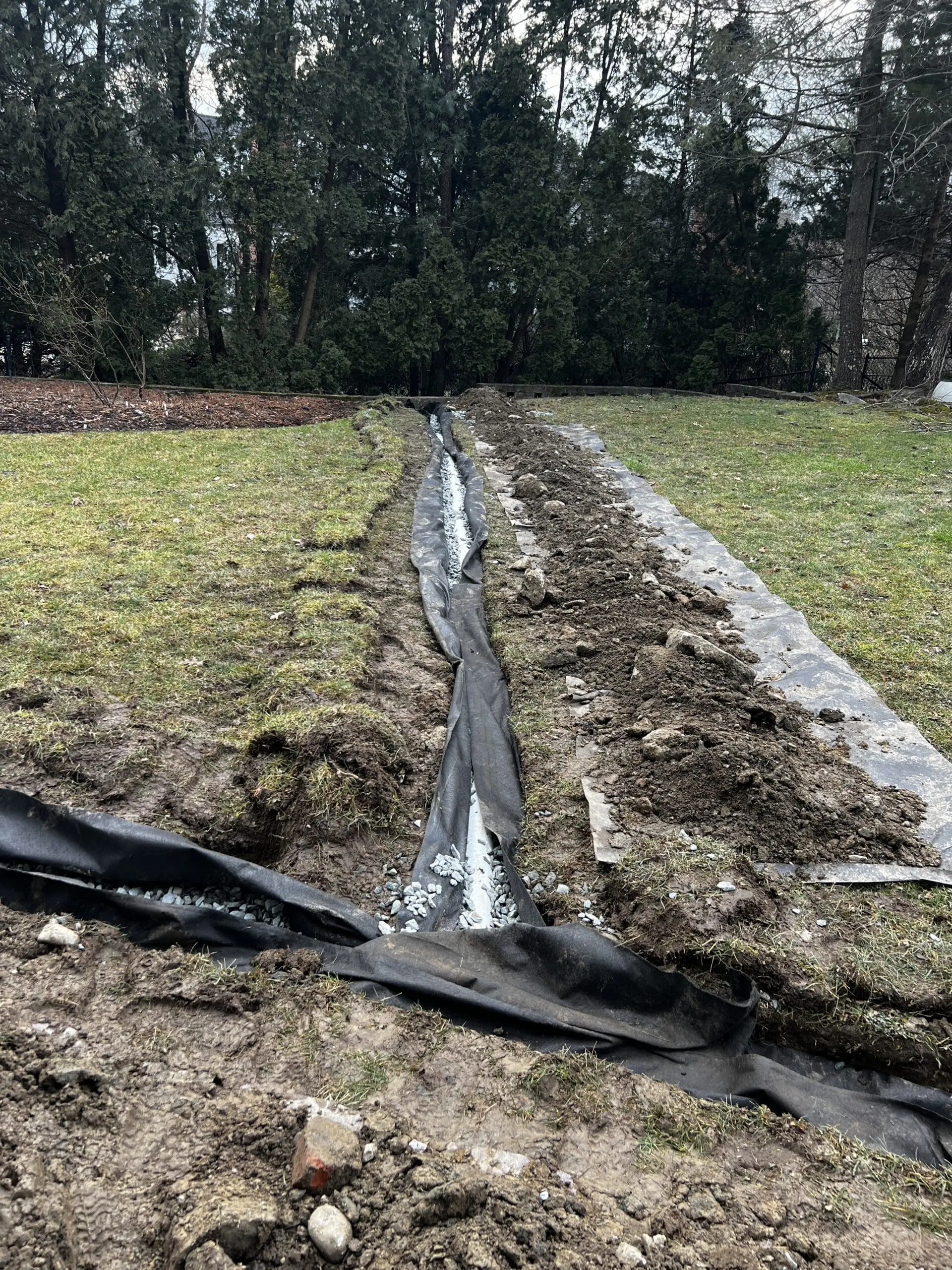Often, when we receive a call regarding landscape drainage issues, it is because the client noticed flooding or seeping into their basement or around the home’s foundation. This, unfortunately, means the problem has likely existed for a while and is coming to a head – the stormwater has nowhere else to go but inside the house. A home improvement contractor might suggest a way to evacuate the water from the home, for example: install a drain in the basement and a sump pump to direct the water already inside the house to the outside. It may be effective in drying out the basement, but it resolves nothing around the outside environment of the house—the source of the flooding. Instead of piecemeal engineering that uses undue energy, we need to look at the landscape drainage and stormwater management issues holistically from roof to ground.
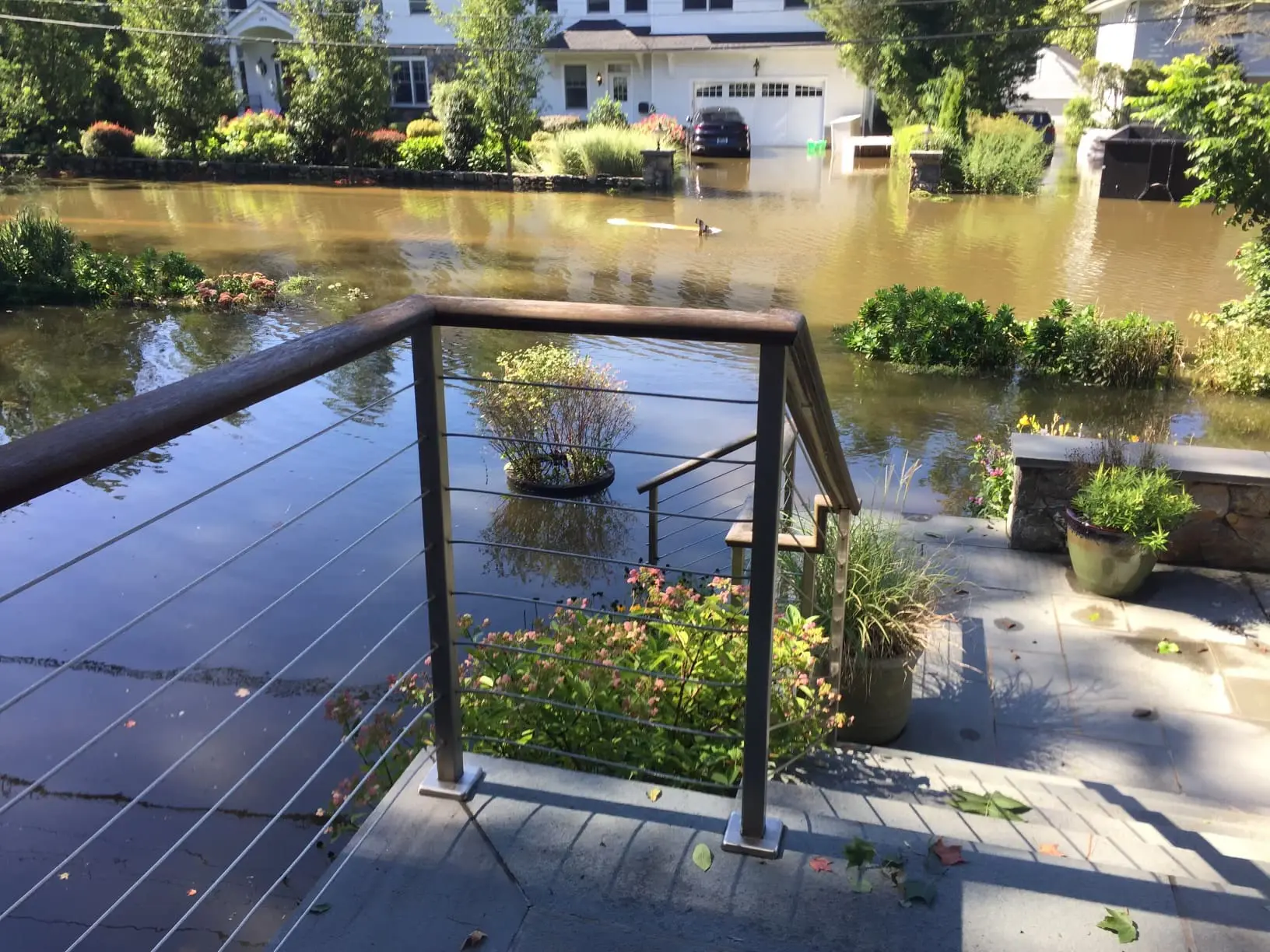
Building codes nationwide mandate that stormwater is captured and managed on site; it is not allowed to run off into the adjacent land. The reason is simple: the more stormwater that is allowed to run off over the roof, driveway, lawn, and other surfaces, the more pollutants it collects. The more run off, the greater velocity of the water, the greater potential to cause erosion and transport topsoil sediment, along with the cocktail of pollutants. All this runoff, uninterrupted, eventually ends in a waterbody of some sort. We must avoid this at all costs. It is much easier to act preventatively to preserve water quality than to clean up a polluted waterway. There are many tools at our disposal to interrupt, capture and direct stormwater on site, and even opportunities to recycle stormwater to irrigate landscape features. Ultimately, our goal is to prevent stormwater runoff, and design systems that allow the water to return to the hydrologic cycle, either by infiltrating to ground aquifers, or by being absorbed by plant roots and returned to the atmosphere through evapotranspiration.
Steps for Analyzing Landscape Drainage
Specific observations and site analysis inform our understanding of your micro-watershed and landscape drainage issues. This crucial analysis guides the design phase of your stormwater management plan. If you experience pooling water or flooding in your home, be sure to investigate the following
Gutters and Leaders:Gutters and leaders can collect pollen, leaves, and other debris, become clogged, and fail to capture and direct stormwater. They should be cleaned 3-4 times a year, especially in the fall and spring. Observe where the leaders discharge to: is it directly onto the lawn, close to the house, or does it “daylight” elsewhere on the property surface?
Foundation: If you have water in the basement, it is likely entering though a crack in the foundation. Modern construction methods require two layers of waterproofing and at least one layer of insulation. If your foundation is up to modern standards and has no evidence of cracking, your leak may by hydrosolic (coming up from a water table below the foundation).
Existing Drainage Systems: Some common drainage solutions in the past are now considered ineffective and outdated. For example, perimeter drains around the foundation of the house were once standard; however, to evacuate the water from the perimeter drain, the storm drain must be at a lower elevation, or the system requires another anti-gravity sump pump, running on electricity. Instead, standard protocol now is to direct stormwater from the roof, through gutters and leaders, into an underground solid pipe pitched away from the house for at least ten feet. From here, it may enter a number of different drainage solutions. Another common mistake we see is the kind of pipe used. Black corrugated pipe is the weakest pipe material and often collapses when installed underground, jeopardizing the entire stormwater management system.
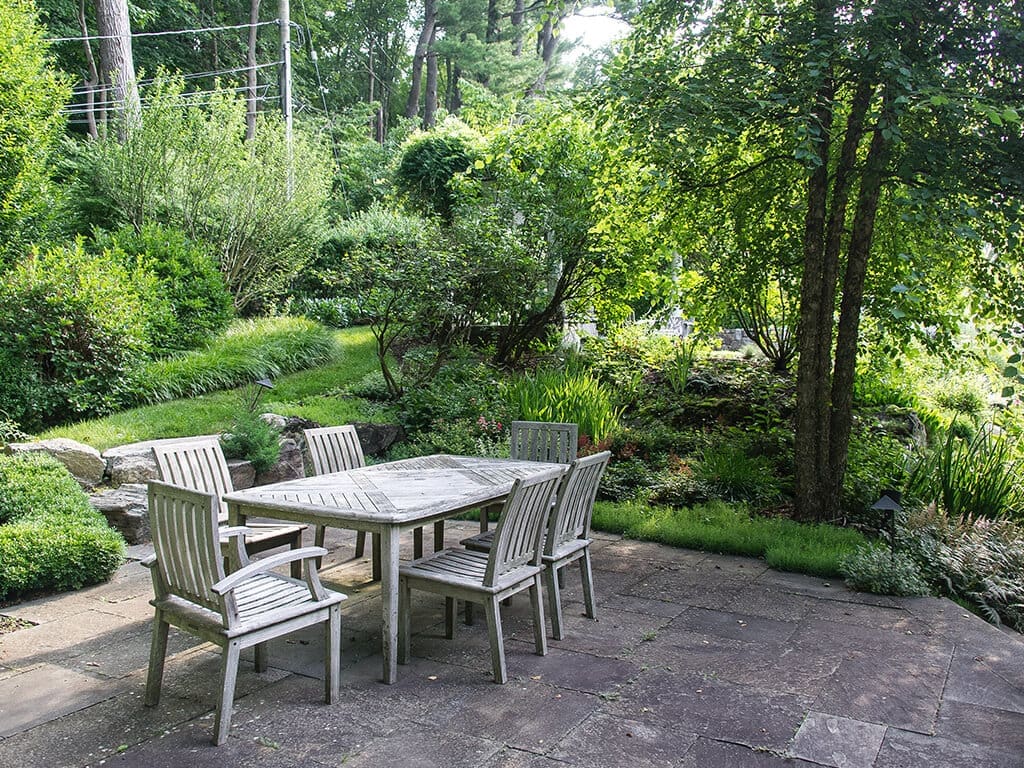
Impervious Space: how much impervious space does your property have, compared to garden beds, naturalized areas, or turf? Impervious space includes your home and all hardscaping (driveways, walkways, patios) where stormwater cannot infiltrate. Turf grass has very little stormwater absorption ability since it is generally compact soil from repeated foot and mower traffic. Building codes also dictate the amount of impervious space that can be on your property to meet the floor area ratio of impervious to pervious space (it is related to the size of your property), however, how you design your pervious space can have a great impact on your property’s ability to absorb stormwater. Another element to consider is the quality of your hardscape. Patios without adequate bases can settle overtime, changing the pitch and sometimes directing stormwater toward the home instead of away from it.
Lawn Area: Lawn is the most dysfunctional element in a stormwater system, after hardscaping. It has virtually no absorption ability and often contributes pollutants to the runoff.
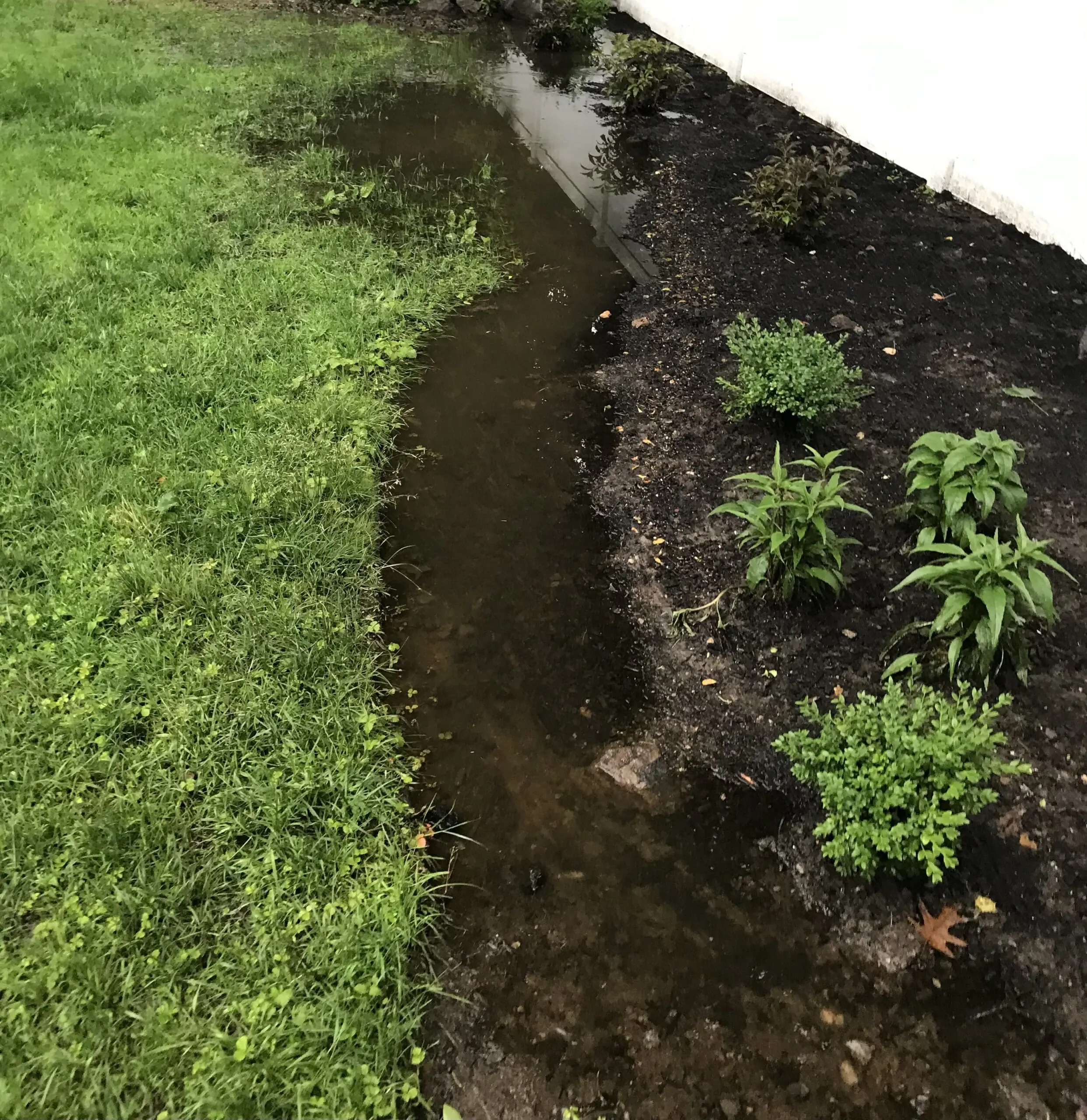
Soil Porosity & Drainage Characteristics: Understanding the characteristics of the soil on site will help determine what landscape drainage options are on the table. A classic way to analyze soil porosity and drainage ability is to conduct a percolation test. Dig a three-foot deep hole and fill it with water, then time how long it takes for the water to drain completely. If it is less than 24 hours, you have sufficient drainage capacity for solutions such as rain gardens and bioswales. If you start digging and hit water before you reach three feet, you are dealing with a high-water table and will need to explore alternative landscape drainage solutions. This can occur if the foundation was poured on a rock shelf, or if compact subsoil excavated for the foundation is now topsoil layer. Both of these scenarios can create what is know as the Bathtub Effect, where water gets trapped in the top few inches of soil and has nowhere else to go.
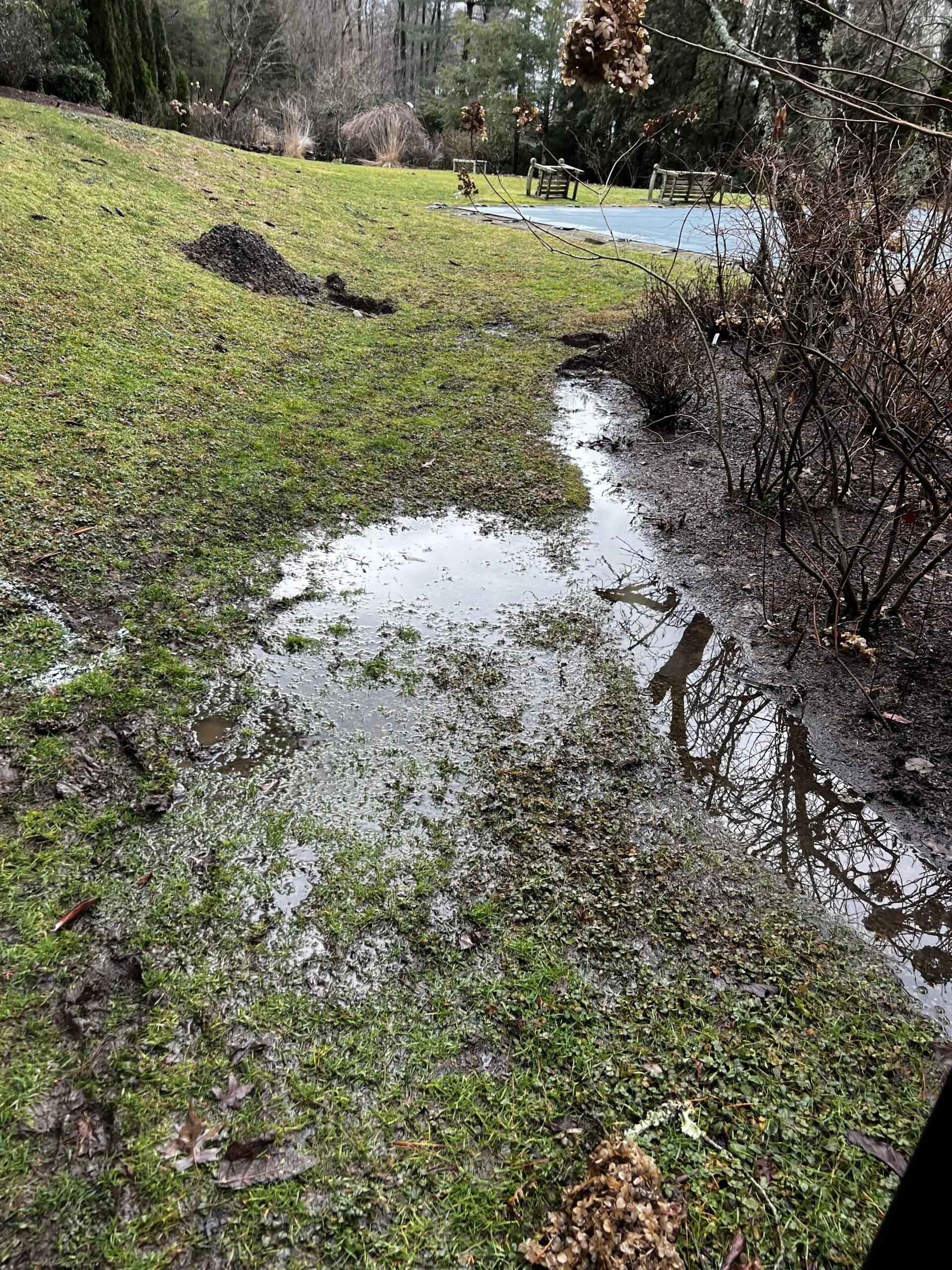
Identify Flow Paths: On a rainy day, carefully observe how water flows through your landscape. Take videos for reference. Notice where water is flowing and where it seems to collect and pool. Flow paths can be influenced by topography (directional flows: uphill or downhill flows) or if there is evident of erosion or scouring, which might suggest corrective measures like grading, terraforming, and land contouring. We analyze possible sites for rain gardens.
Surrounding Land: Observe your neighbor’s properties and their impact on your land. Are you at the bottom of the neighborhood or the top? Have your neighbors recently developed their home or landscape in anyway that might divert or fail to capture stormwater? For example – an addition on the house, a new patio or pool, a newly levelled lawn area – all of these developments can influence the watershed and potentially direct more stormwater onto your property. Does water that falls on adjacent to the property end on a road, a lawn, a pond, a garden bed? Are there adjacent treatment wetlands? We want to interrupt the flow to eliminate point source pollution. Stormwater runoff is a primary method of nutrient leaching from particulate matter, geese poop, lawn chemicals, roofing chemicals and more.
Designing a Stormwater Management Plan
Once we identify where the water is coming from and where it is going, we can understand how to put it to good use. With proper site analysis, we can put together a stormwater management plan for the property that also considers the land adjacent to your property borders. We need to think more holistically and creatively about how we manage the water, understanding the volume its great potential for benefit and damage. How can we use this precious resource? Below we explain some tools in our landscape drainage toolbox. Of course, there is no one-size fit all plan, and often we need to combine multiple strategies to effectively manage extreme storm events.
Landscape Drainage Solutions:
- Swales and Bioswales: Swales are channels that direct stormwater from one point to another on the surface of the landscape. They are often filled with gravel and/or river rock for a more decorative finish. Swales can be stand alone or vegetated, with plantings on either side to add additional absorption capacity.
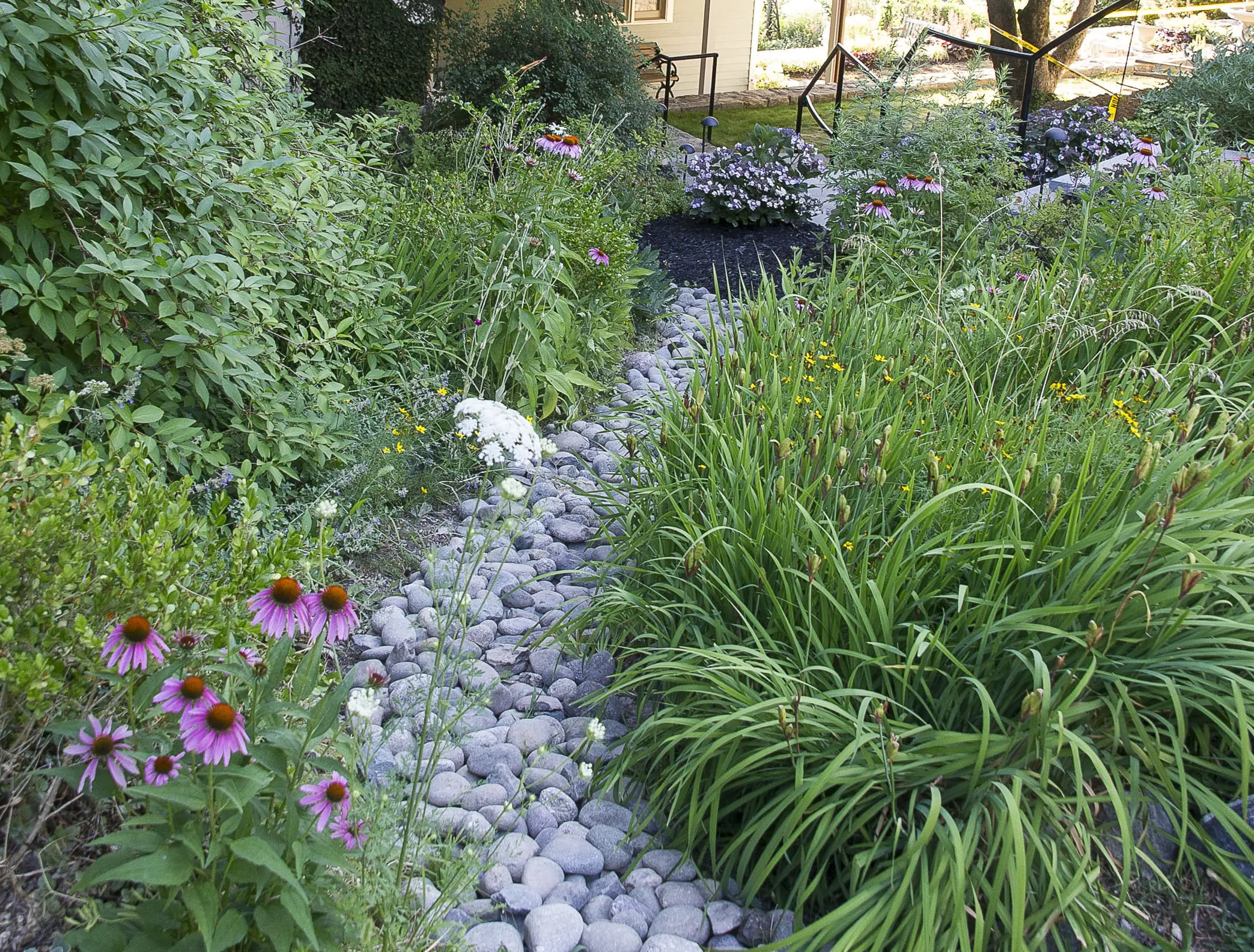

- Armoring or Vegetating Slopes: If erosion is evident, we can deploy solutions to protect slopes, including installing stone or boulders to “armor” the slope and by planting any exposed soil. Plant roots help secure topsoil during storm events and increase absorption capacity.
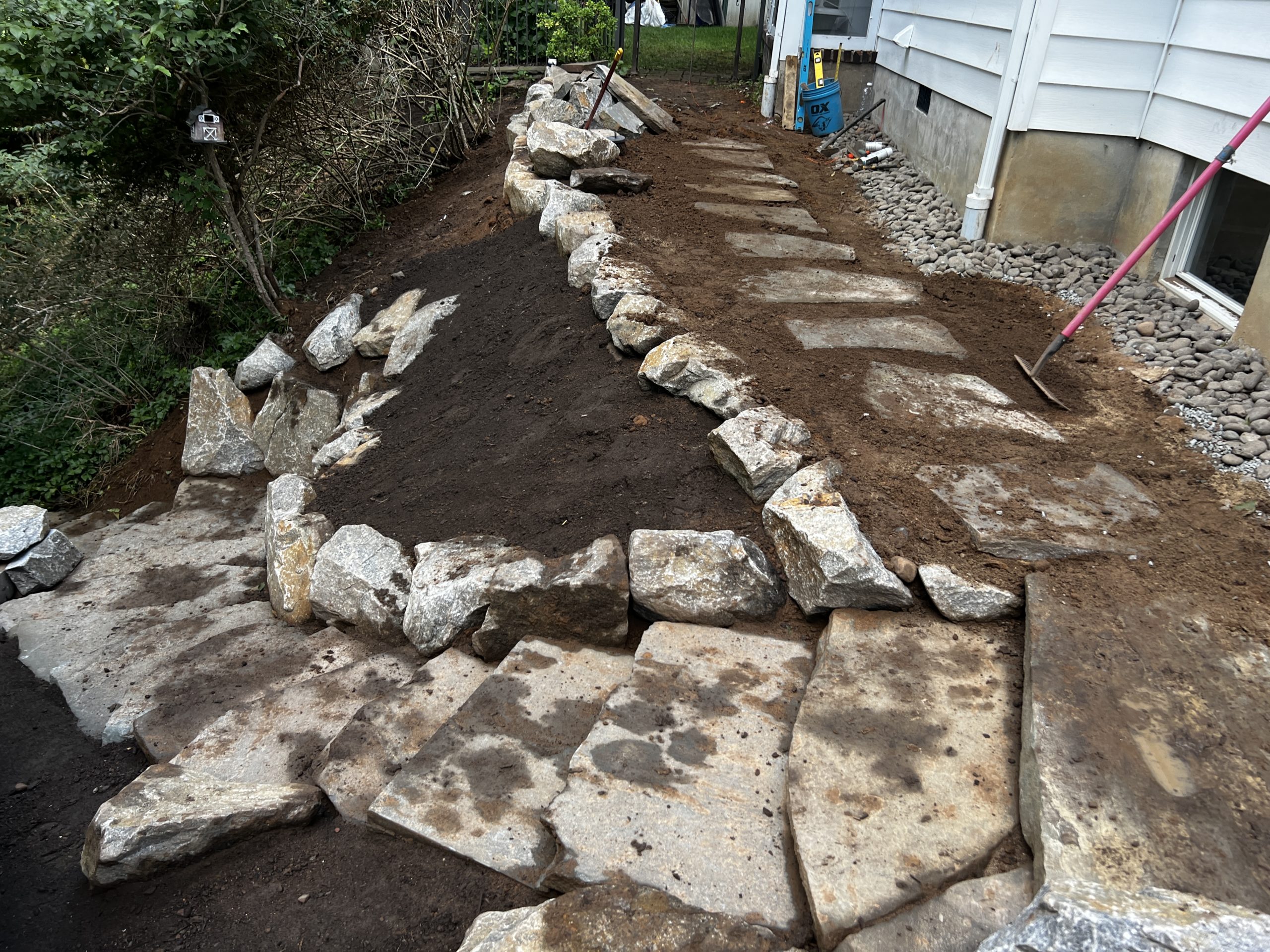
- Erosion Control Methods: Compostable erosion socks are often used in our erosion control projects because they physically interrupt stormwater flow and give it time to seep into the planting on the slope. Jute netting is also useful in securing plantings on a slope in place until the root system becomes fully established. Straw blankets and tackifieid hay are used in a similar fashion to secure newly seeded slopes. Hydroseeding allows large, sloped areas to be seeded at once, a solution often used in large restoration projects.
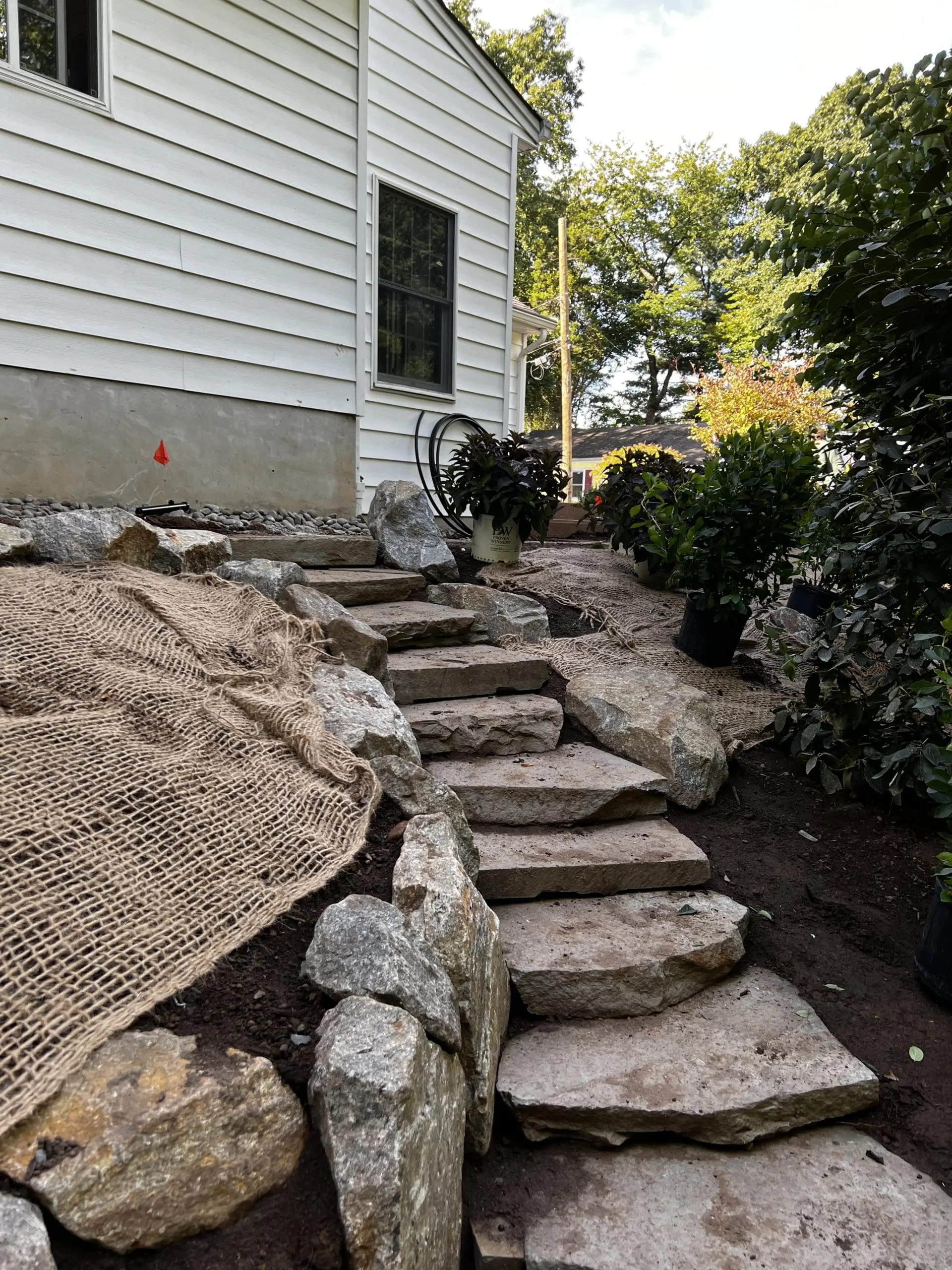
- Rain Gardens: Rain gardens are depressed or excavated garden areas planted with native plants that can effectively hold and absorb stormwater during storm events, giving it time to be routed through plant roots and out their leaves through evapotranspiration. Rain gardens are not bog gardens, and the plants need to be able to survive periods of drought as well. Rain gardens should be sited to interrupt the flow of water, not where water already pools or becomes trapped. Deep rooted grasses, native shrubs and perennials with a large root to shoot ratio help direct water to the sub aquifer via penetration from the roots. This is key for landscape sustainability. See our previous blog for more info.
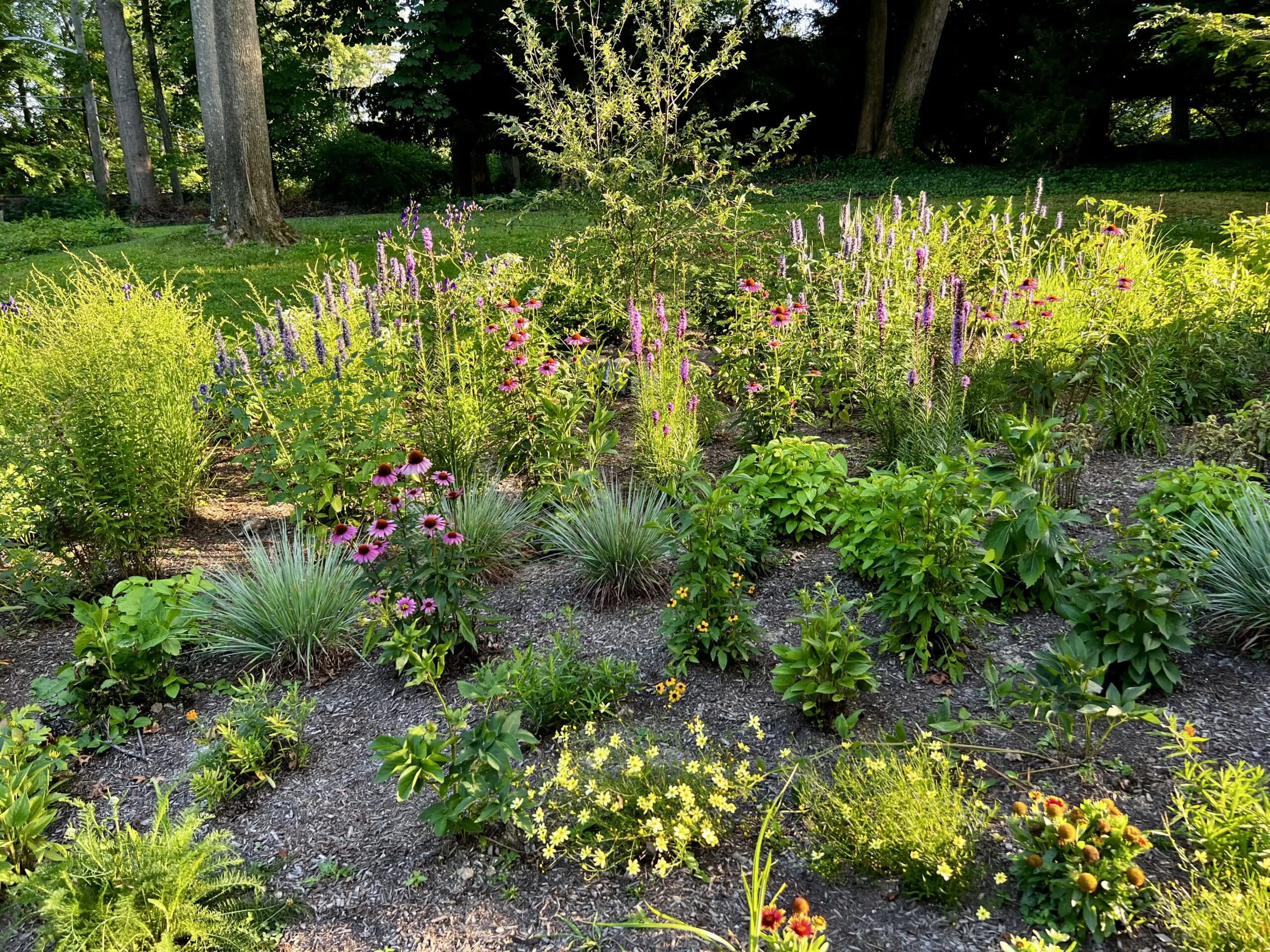
- Grading & Land Contouring: Manipulating grades through land contouring and terraforming is another effective strategy for slowing down stormwater. Creating an undulating landscape through berms, terraces and other design features disperses the impact of stormwater and creates a more interesting landscape.

- Soil Amendments to Reduce Compaction: Suburban soils, especially lawns, become more and more compact over time. The air space collapses, and they have virtually no water-holding capacity. Clay particles bond to water molecules and hold water on the surface, creating surface and temporal ponding. Fortunately, this can be improved by applying wetting agents and surfactants to enhance stormwater penetration. We can also physically alter the soil structure through core aeration. We can also amend the soil with green sand, azomite, gypsum, compost, and more to improve the physical characteristics of the soil. Leaving leaves and lawn clippings throughout the year contributes more organic matter to the soil A Horizon, improving the infiltration rate.

- Vegetative Buffers Around Waterbodies, Wetlands: Waterbodies must be protected from stormwater runoff. The best way to do so is to design a ten-foot vegetative buffer around the waterbody to prevent nutrient leaching from the lawn and surrounding area. Treatment wetlands (look for cattails, phragmites or bullrush) are a valuable flood prevention resource and filtration system. Stormwater will eventually get there (that’s the function ), but if we can pre-filter the stormwater via a rain garden or vegetative buffer to interrupt the flow between the upper watershed and the treatment wetland, our wetlands will stay healthier. Wetland plants are great at cleaning water, but we still want to avoid getting pollutants from roads, roofs, lawn, our wetlands will be more effective and resilient. Healthy soil biology in the vegetative buffer will break down pollutants before it ever gets down to the wetland.
- More Planting, Less Lawn: here in the tri-state area, because of the extraordinary amount of rain fall, the trees cannot evapotranpirate the water fast enough to dry the surface and subsurface landscape. Lawns are compact and shallow-rooted, making them ineffective at infiltrating stormwater to the aquifer. Plants have greater biomass and root to shoot ratio and are infinitely better at this than the ubiquitous great American lawn.
-

Trench drain installation across a lawn area. - Perimeter Drains, French Drains, Curtain Drains: Perforated PVC pipe surrounded by washed gravel and geotextile fabric, invites the water in from the surface and allows it to infiltrate into the ground. Allows surface water or water from leaders to be captured and directed.
- Infiltration Trenches & Vertical Infiltrators: Perpendicular pieces of perforated pipe are connected to horizontal trench drains to increase the ability to conduct surface water into the subsoil. Mostly used to improve landscape drainage in lawn areas.
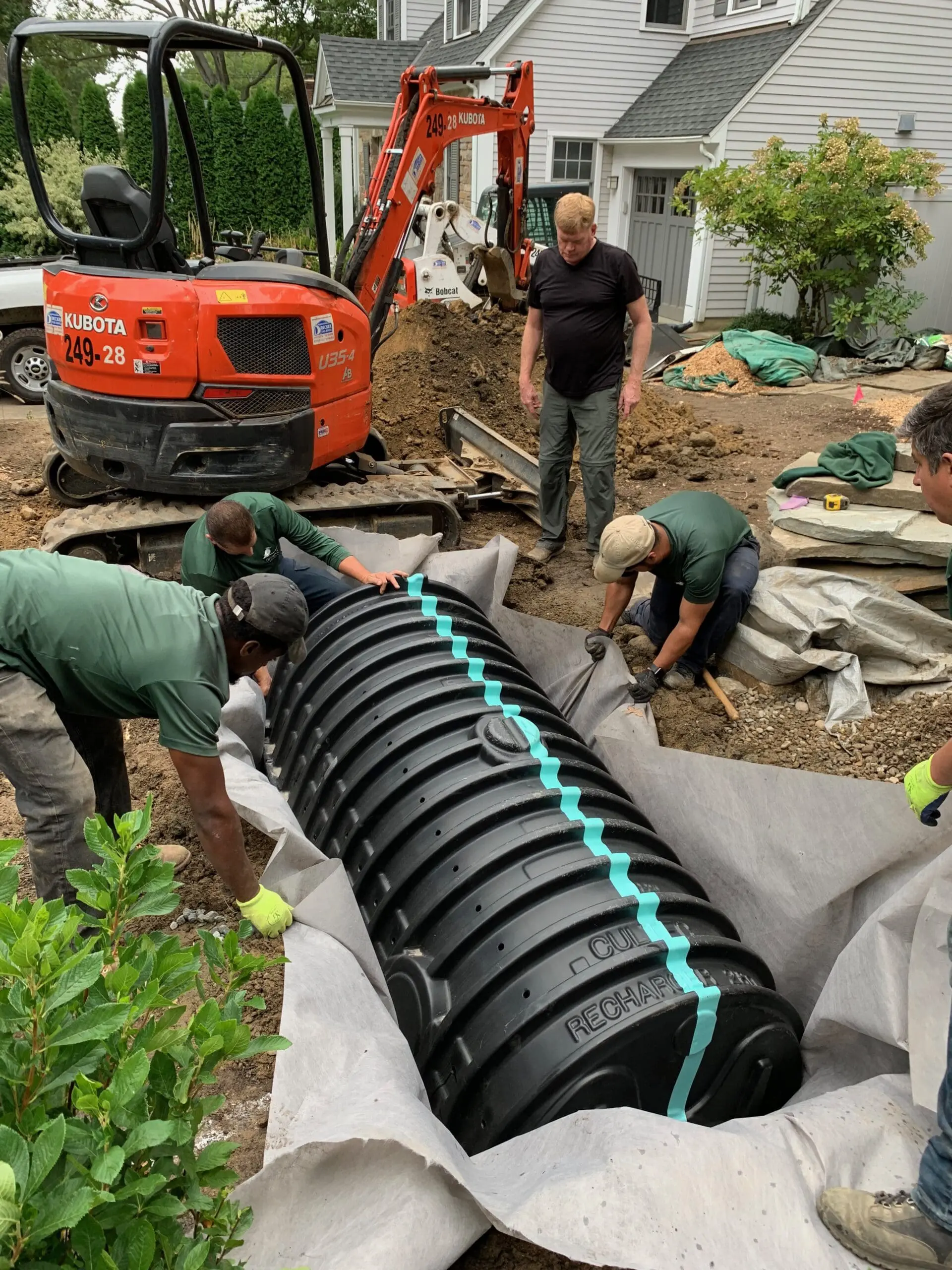
- NDS Flow Wells, Cultecs, Storm Chambers: Large underground storage system with an open bottom to allow water to trickle out through gravel and filter fabric. These systems are often connected to leaders of the house through solid underground piping. These are traditional physical engineering systems.
Hopefully this summary of analyzing landscape drainage issues and developing a stormwater management plan was helpful! If you’d like to discuss your landscape drainage issues, contact us to schedule a site visit.
